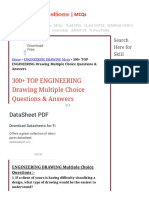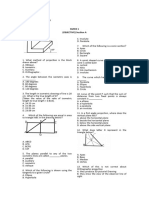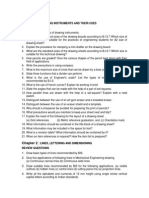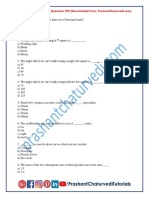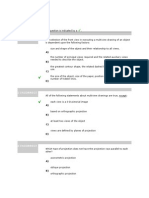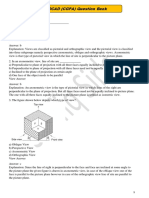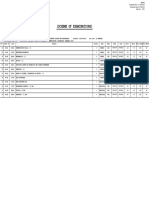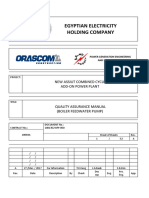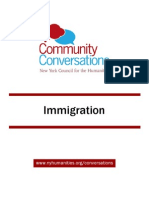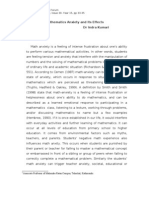Results Reporter: Multiple Choice Questions
Results Reporter: Multiple Choice Questions
Uploaded by
Satyam SinghCopyright:
Available Formats
Results Reporter: Multiple Choice Questions
Results Reporter: Multiple Choice Questions
Uploaded by
Satyam SinghOriginal Description:
Original Title
Copyright
Available Formats
Share this document
Did you find this document useful?
Is this content inappropriate?
Copyright:
Available Formats
Results Reporter: Multiple Choice Questions
Results Reporter: Multiple Choice Questions
Uploaded by
Satyam SinghCopyright:
Available Formats
Multiple Choice Questions
1 of 3
http://highered.mheducation.com/sites/0073655988/student_view0/chapt...
Home > Chapter 8 > Multiple Choice Questions
Course-wide Content
AutoCAD Exercises
Multiple Choice Questions
News, Articles & Links
Web Links
Quizzes
True/False Quiz Questi...
Multiple Choice Que...
Questions for Review
Visualization Exercise A
Visualization Exercise B
Visualization Exercise C
Visualization Exercise D
Interactive Exercises
Flashcards
Animations
More Resources
Chapter Overview
Learning Objectives
Chapter Outline
Image Library
Results Reporter
(See related pages)
Out of 30 questions, you answered 7 correctly with a final grade of 23%
7 correct (23%)
23 incorrect (77%)
0 unanswered (0%)
Your Results:
The correct answer for each question is indicated by a
1
INCORRECT
The selection of the front view in executing a multiview drawing of an object is dependent upon the following factors:
A) size and shape of the object and their relationship to all views.
B) the number of principal views required and the related auxiliary views needed to describe the object.
C) the greatest contour shape, the related dashed lines, and the position of use.
D) the size of the object, size of the paper, position of use, and least number of hidden lines.
2 CORRECT
All of the following statements about multiview drawings are true, except:
A) each view is a 3-D pictorial image
B) based on orthographic projection
C) at least two views of the object
D) views are defined by planes of projection
3
INCORRECT
Which type of projection does not have the projection rays parallel to each other?
A) axonometric projection
B) oblique projection
C) orthographic projection
D) perspective projection
4
INCORRECT
Which is not a principal view?
A) bottom
B) left side
C) auxiliary
D) front
5
INCORRECT
Principle planes will appear as:
A) normal planes or edges
B) oblique planes or edges
C) normal planes or oblique planes
D) skewed planes or edges
6 CORRECT
In orthographic projection, visual rays or lines of sight for a given view are _____________ to each other.
A) perpendicular
B) oblique
C) normal
D) parallel
7
INCORRECT
What two types of projections give a pictorial view of the object without convergence?
A) orthographic and perspective
B) oblique and axonometric
C) perspective and oblique
D) isometric and orthographic
8
INCORRECT
Inclined planes in a three-view drawing will appear as:
A) two surfaces and one edge
B) two edges and one surface
C) three edges
D) foreshortened in each view
9
INCORRECT
Oblique planes in a three-view drawing will appear as:
A) two surfaces and one edge
B) two edges and one surface
C) three edges
D) three surfaces
10
INCORRECT
Normal planes in a three-view drawing will appear as:
A) one surface and two edges
B) three surfaces
C) one edge and two surfaces
D) three edges
11
CORRECT
A viewing direction which is perpendicular to the surface in question gives a(n) ____________ view.
A) inclined
2/24/2015 8:32 PM
Multiple Choice Questions
2 of 3
http://highered.mheducation.com/sites/0073655988/student_view0/chapt...
B) normal
C) oblique
D) perspective
12
INCORRECT
A viewing direction which is parallel to the surface in question gives a(n) ____________ view.
A) inclined
B) normal
C) edge
D) perspective
13
INCORRECT
When a surface of an object is inclined to a plane of projection, it will appear _________________ in the view.
A) foreshortened
B) in true size and shape
C) as a line
D) as a point
14
INCORRECT
What are the three principle planes in orthographic projection?
A) front, top, profile
B) back, top, profile
C) top, front, right side
D) frontal, horizontal, profile
15
INCORRECT
The top view of an object should typically be drawn:
A) to the right of the front view.
B) anywhere on the same page.
C) directly above the front view.
D) on a separate piece of paper.
16
INCORRECT
A horizontal surface of a multiview drawing will appear as a(n) ___________ in the front view.
A) edge
B) normal surface
C) point
D) foreshortened surface
17
INCORRECT
Which view is usually developed first, contains the least amount of hidden lines, and shows the most contours in multiview drawings?
A) right side
B) top
C) back
D) front
18
INCORRECT
A sphere can be described in how many views?
A) 4
B) 3
C) 2
D) 1
19
CORRECT
An asymmetric object is usually described by how many views?
A) 6
B) 3
C) 4
D) 2
20
CORRECT
An axially symmetric object, such as one turned on a lathe, normally can be shown in _________ view(s).
A) one
B) two
C) three
D) four
21
INCORRECT
In orthographic projection, visual rays are __________ to the projection plane.
A) parallel
B) adjacent
C) perpendicular
D) tangent
22
INCORRECT
The top and right side views have what common dimension(s)?
A) height and width
B) width and depth
C) height
D) depth
23
INCORRECT
For orthographic projection, the engineering custom in the United States dictates the use of:
A) first-angle projection
B) second-angle projection
C) third-angle projection
D) fourth-angle projection
24
INCORRECT
For orthographic projection, the engineering custom in Europe dictates the use of:
A) first-angle projection
B) second-angle projection
2/24/2015 8:32 PM
Multiple Choice Questions
3 of 3
http://highered.mheducation.com/sites/0073655988/student_view0/chapt...
C) third-angle projection
D) fourth-angle projection
25
INCORRECT
The sequence for the direction of view (or line of sight) for any orthographic projection as utilized in the United States is:
A) eye of observer>projection plane>object
B) eye of observer>object>projection plane
C) projection plane>object>eye of observer
D) projection plane>eye of observer>object
26
INCORRECT
Depending on its relationship to the projection plane on which the view is projected, a line may project:
A) true length
B) foreshortened
C) as a point
D) all of the above
27
CORRECT
If a surface on an object is parallel to one of the principal planes of projection, then the angular relationship of that surface to at least two other principal projection
planes is:
A) parallel
B) perpendicular
C) inclined
D) unknown
28
CORRECT
Good practice dictates that the characteristic contour shape of the object be shown in what view?
A) top
B) front
C) right side
D) any side
29
INCORRECT
The height, width, and depth of an object can be shown with a minimum of how many orthographic projection views?
A) six
B) three
C) two
D) four
30
INCORRECT
Which of the following pairs of orthographic views both show the height dimension?
A) left side and front
B) top and front
C) top and rear
D) bottom and right side
E-mail Your Results
Date: Tue Feb 24 2015 20:32:00 GMT+0530 (India Standard Time)
My name:
Section ID:
E-mail these results to:
E-mail address:
Format:
Me:
My Instructor:
My TA:
Other:
To learn more about the book this website supports, please visit its Information Center.
2003 McGraw-Hill Higher Education
Any use is subject to the Terms of Use and Privacy Policy.
McGraw-Hill Higher Education is one of the many fine businesses of The McGraw-Hill Companies.
Online Payroll
Gmail Account
Best Cell Phone
New Cell Phone
Direct Tv Offers
Crossover SUV
2/24/2015 8:32 PM
You might also like
- The Essential Husserl by Dann WeltonDocument444 pagesThe Essential Husserl by Dann Weltonselfkiller90% (10)
- TD QuestionsDocument9 pagesTD QuestionsTope YomiNo ratings yet
- Chapter 18 Multiple Choice Questions With Answers 2Document3 pagesChapter 18 Multiple Choice Questions With Answers 2Prabhakar Sharma68% (19)
- Multi View Drawing TestDocument15 pagesMulti View Drawing TestTaruun Vaiddya100% (1)
- Core BeliefsDocument4 pagesCore BeliefsJames StephensNo ratings yet
- Eg MCQDocument61 pagesEg MCQAvin GhodasaraNo ratings yet
- MCQ 2013-14Document13 pagesMCQ 2013-14Kishor Patil100% (1)
- Engg. Drawing (MCQ)Document19 pagesEngg. Drawing (MCQ)Jagdeep Pundir100% (1)
- Engineering DrawingDocument16 pagesEngineering DrawingSabeeh HasnainNo ratings yet
- Sample Test Question in Technical Drawing 1Document4 pagesSample Test Question in Technical Drawing 1Jhing Ibañez TiborNo ratings yet
- 300+ TOP ENGINEERING Drawing Multiple Choice Questions & Answers HhajsbsiDocument17 pages300+ TOP ENGINEERING Drawing Multiple Choice Questions & Answers HhajsbsiANWAAR HUSSAIN100% (2)
- Engg Drawing QuestionsDocument30 pagesEngg Drawing QuestionsVarun Shastry50% (2)
- Multiple Choice Questions FULLDocument7 pagesMultiple Choice Questions FULLRɩsʜʌv SɩŋʛʜNo ratings yet
- Engineering Objective, MCQ QuestionDocument3 pagesEngineering Objective, MCQ Questionhiteshsoft78% (9)
- Engineering Drawing OBJECTIVE BITS With Answers - M V ReddyDocument6 pagesEngineering Drawing OBJECTIVE BITS With Answers - M V ReddyVenkateswar Reddy Mallepally86% (7)
- 1 MarksDocument33 pages1 MarksSri RamNo ratings yet
- Answer: Option ADocument28 pagesAnswer: Option ADhananjay KadamNo ratings yet
- Cad MCQ 1Document4 pagesCad MCQ 1Vikram RathoreNo ratings yet
- Engg Drawing MCQDocument93 pagesEngg Drawing MCQPraveen Dwivedi100% (1)
- Basic Questions 48Document12 pagesBasic Questions 48ajayNo ratings yet
- SS 2 TD EXAM QuestionsDocument4 pagesSS 2 TD EXAM QuestionsTriplejayartNo ratings yet
- BES 122 Quiz 1Document23 pagesBES 122 Quiz 1Gabriel RamosNo ratings yet
- Engineering Drawing Sample QuestionDocument10 pagesEngineering Drawing Sample QuestionDeepakDhimanNo ratings yet
- Engineering DrawingDocument17 pagesEngineering DrawingprashmceNo ratings yet
- Cad MCQSDocument18 pagesCad MCQSTahir Hussain Soomro100% (1)
- Test - CADDocument2 pagesTest - CADIonescu Viorel50% (2)
- AutoCAD Frequently Asked Interview QuestionsDocument23 pagesAutoCAD Frequently Asked Interview Questionskishore.pd3d94% (34)
- Chapter 02 Multiple Choice Questions With Answers (3 Files Merged)Document6 pagesChapter 02 Multiple Choice Questions With Answers (3 Files Merged)Shiva Shankar67% (3)
- Objective Question Bank On Engineering DRDocument56 pagesObjective Question Bank On Engineering DRpushpeshNo ratings yet
- SS 2 TD EXAM Questions UpdatedDocument4 pagesSS 2 TD EXAM Questions UpdatedTriplejayartNo ratings yet
- Eg Sample MCQ Unit IIDocument2 pagesEg Sample MCQ Unit IITara Chandra PanjiyarNo ratings yet
- Objective Questions Bank On Engineering Drawing For EseDocument53 pagesObjective Questions Bank On Engineering Drawing For EseHisham Feroz100% (1)
- 1st B.tech Engineering Graphics Question BankDocument9 pages1st B.tech Engineering Graphics Question BankDrkumar SwamyNo ratings yet
- PDFDocument43 pagesPDFPruthvi KavaiyaNo ratings yet
- ED Multiple Choice QuestionsDocument7 pagesED Multiple Choice QuestionsLaxmireddy Peram43% (7)
- Autocad MCQDocument6 pagesAutocad MCQhelp eduzphereNo ratings yet
- Engineering Drawing MCQDocument23 pagesEngineering Drawing MCQYogendra Kumar100% (1)
- MCQ For DrawingDocument12 pagesMCQ For DrawingKomal Srivastava33% (3)
- Engineering Drawing Textbook Intro by N D BhattDocument6 pagesEngineering Drawing Textbook Intro by N D Bhattpoetmba54% (26)
- Stair Case MCQDocument7 pagesStair Case MCQJayesh JagtapNo ratings yet
- Engineering Drawing Form 4 - Figure of Equal AreaDocument13 pagesEngineering Drawing Form 4 - Figure of Equal AreaDo The CuongNo ratings yet
- MCQ Engineering Drawing BasicDocument3 pagesMCQ Engineering Drawing BasicDeepakDhiman100% (4)
- Subject QA Surveying InitialkeyDocument17 pagesSubject QA Surveying InitialkeynarendrananiNo ratings yet
- Engineering Drawing and Graphics - Basant Agrawal & C M Agrawal - Multiple Choice QuestionsDocument4 pagesEngineering Drawing and Graphics - Basant Agrawal & C M Agrawal - Multiple Choice QuestionsShahbaz Alam0% (2)
- Oblique ProjectionDocument18 pagesOblique ProjectionJoy OramaNo ratings yet
- Autocad MCQDocument5 pagesAutocad MCQmulayharsh003No ratings yet
- Engineering Drawing MCQ Prashantchaturvedi - Com 1Document24 pagesEngineering Drawing MCQ Prashantchaturvedi - Com 1Nandan SarkarNo ratings yet
- Engineering DrawingDocument5 pagesEngineering DrawingSainadhReddy100% (4)
- SSS3 TD CAT 2nd TermDocument7 pagesSSS3 TD CAT 2nd TermFagbohunka EricNo ratings yet
- Ss2 Technical Drawing Lesson Plan Week 3Document4 pagesSs2 Technical Drawing Lesson Plan Week 3Joy OramaNo ratings yet
- SS2 Tech Drawing 1st Term E-NoteDocument48 pagesSS2 Tech Drawing 1st Term E-NoteJesseNo ratings yet
- PDFDocument30 pagesPDFvcmadarsh50% (2)
- MCQ - AutocadDocument2 pagesMCQ - AutocadMATHEWSKIZHAKKEVEETT0% (1)
- AutoCAD Interview QuestionsDocument4 pagesAutoCAD Interview Questionsykamalsai3204No ratings yet
- Electrical DwringDocument15 pagesElectrical DwringImtiax LaghariNo ratings yet
- New Assignment - 2 - Eg-23-24Document6 pagesNew Assignment - 2 - Eg-23-24chauhanshiv546No ratings yet
- EG Basics MCQ - 1Document8 pagesEG Basics MCQ - 1WAJID AJMALNo ratings yet
- MDCAD (CGPA) Question Bank: MpgisoeDocument36 pagesMDCAD (CGPA) Question Bank: MpgisoeDhananjay KadamNo ratings yet
- Ss 3 Technical Drawing Exam QDocument3 pagesSs 3 Technical Drawing Exam QTriplejayartNo ratings yet
- 15876360051587147642eng 232 QuestionsDocument6 pages15876360051587147642eng 232 QuestionsJoy OramaNo ratings yet
- Machine Drawing and CADDocument84 pagesMachine Drawing and CADDhananjay KadamNo ratings yet
- MCQ For EGDocument5 pagesMCQ For EGretailrover.ecomNo ratings yet
- (Batch:PCB1) Mrunal's Economy Pillar#2: Budget Revenue 15 FC, Black Money, Subsidies Page 241Document39 pages(Batch:PCB1) Mrunal's Economy Pillar#2: Budget Revenue 15 FC, Black Money, Subsidies Page 241Satyam Singh0% (1)
- Tax Invoice/Bill of Supply/Cash Memo: (Original For Recipient)Document1 pageTax Invoice/Bill of Supply/Cash Memo: (Original For Recipient)Satyam SinghNo ratings yet
- Fluid Mechanics & Machines Part 2 PDFDocument100 pagesFluid Mechanics & Machines Part 2 PDFSatyam SinghNo ratings yet
- Itr-1 Sahaj Indian Income Tax Return: Acknowledgement Number: 996215700300819 Assessment Year: 2019-20Document6 pagesItr-1 Sahaj Indian Income Tax Return: Acknowledgement Number: 996215700300819 Assessment Year: 2019-20Satyam SinghNo ratings yet
- Engineering Drawing and Graphics - Basant Agrawal & C M Agrawal - Multiple Choice QuestionsDocument4 pagesEngineering Drawing and Graphics - Basant Agrawal & C M Agrawal - Multiple Choice QuestionsShahbaz Alam0% (2)
- Class 3rd MathDocument45 pagesClass 3rd MathSatyam SinghNo ratings yet
- PsychometryDocument1 pagePsychometrySatyam SinghNo ratings yet
- Select Question Question 58 Out of 65: Fill in The Blank(s)Document1 pageSelect Question Question 58 Out of 65: Fill in The Blank(s)Satyam SinghNo ratings yet
- AnnelingDocument31 pagesAnnelingSatyam Singh100% (1)
- THESIS On Composite MaterialDocument87 pagesTHESIS On Composite MaterialSatyam Singh100% (5)
- Application Form: Job Priority Job NameDocument2 pagesApplication Form: Job Priority Job NameSatyam SinghNo ratings yet
- CSPC Midterm ActivitiesDocument22 pagesCSPC Midterm ActivitiesMark Anthony RamosNo ratings yet
- 5399 5668 02Document19 pages5399 5668 02Ashok KarriNo ratings yet
- Essay Question CollectivisationDocument2 pagesEssay Question CollectivisationKatie MillsNo ratings yet
- FRANKENSTEIN Vocabulary - LettersDocument5 pagesFRANKENSTEIN Vocabulary - LettersPaula LazarteNo ratings yet
- Instant Access To Italian Elitism and The Reshaping of Democracy in The United States 1st Edition Giorgio Volpe Ebook Full ChaptersDocument60 pagesInstant Access To Italian Elitism and The Reshaping of Democracy in The United States 1st Edition Giorgio Volpe Ebook Full Chaptersminhwayile100% (13)
- CV4011-PT1 Lecturenote 4-Or - CPM 1516 S1Document17 pagesCV4011-PT1 Lecturenote 4-Or - CPM 1516 S1Steven KuaNo ratings yet
- Christianity and Medieval LiteratureDocument7 pagesChristianity and Medieval LiteraturePatricia RajanNo ratings yet
- Guidelines For Summer Training Report - UUDocument5 pagesGuidelines For Summer Training Report - UUNamanNo ratings yet
- ResultDocument48 pagesResultmalik deepakNo ratings yet
- "DO WHAT THOU WILT": THE SATANIC MANDATE (Satan's Deception. Aleister Crowley. John Lennon. Sergeant Pepper. Hendrix. Beatles, Rock music. Rap. Pop. Hollywood movies. "Stairway to Heaven". End Times. Revelation. Door to Hell. Led Zeppelin. Darth Vader. Rick Warren. False Teachers. False Grace.)Document7 pages"DO WHAT THOU WILT": THE SATANIC MANDATE (Satan's Deception. Aleister Crowley. John Lennon. Sergeant Pepper. Hendrix. Beatles, Rock music. Rap. Pop. Hollywood movies. "Stairway to Heaven". End Times. Revelation. Door to Hell. Led Zeppelin. Darth Vader. Rick Warren. False Teachers. False Grace.)Servant of ChristNo ratings yet
- Optimization Problems and Algorithms (6 Hours) : - 1. Aim of This Practical WorkDocument10 pagesOptimization Problems and Algorithms (6 Hours) : - 1. Aim of This Practical Workgurunathan14No ratings yet
- 1601352-BFP-050 - Quality Assurance Manual For BFP - Rev.ADocument52 pages1601352-BFP-050 - Quality Assurance Manual For BFP - Rev.AMena KamelNo ratings yet
- Still Puritan After All These Years Analysis Practice MMDocument4 pagesStill Puritan After All These Years Analysis Practice MMAndrew MNo ratings yet
- Wind Loading ChainDocument3 pagesWind Loading ChainIbrahim TarekNo ratings yet
- ClaimsDocument23 pagesClaimsDaniel CayabyabNo ratings yet
- Morphology: The - Sleep - Walk - Ing - Albatross - Chant - Ed - A - Dream - y - LullabyDocument34 pagesMorphology: The - Sleep - Walk - Ing - Albatross - Chant - Ed - A - Dream - y - LullabykrostinichuNo ratings yet
- 3 FactorDocument5 pages3 FactormariamNo ratings yet
- Success in The 21st Century May2017Document9 pagesSuccess in The 21st Century May2017Esther CondeNo ratings yet
- Analisis Silibus KimiaDocument3 pagesAnalisis Silibus Kimiabig_biqNo ratings yet
- Core Value ActualisationDocument5 pagesCore Value ActualisationAshutosh PandeNo ratings yet
- Community Conversations Immigration ToolkitDocument10 pagesCommunity Conversations Immigration ToolkitNew York Council for the HumanitiesNo ratings yet
- Mock Test Four: Uee Preparation Course 2019-2020Document3 pagesMock Test Four: Uee Preparation Course 2019-2020213124No ratings yet
- The Way You Make Me FeelDocument20 pagesThe Way You Make Me FeelJose Eduardo Quispe CarlosNo ratings yet
- Math Anxiety and Its Effects1Document6 pagesMath Anxiety and Its Effects1Indra Kumari BajracharyaNo ratings yet
- HypatiaDocument12 pagesHypatiaDragana Modesty100% (1)
- Anthropology 300 Winter 2011 SyllabusDocument5 pagesAnthropology 300 Winter 2011 SyllabusJames Jaeha BanNo ratings yet
- HamletDocument12 pagesHamletRiyadNo ratings yet










